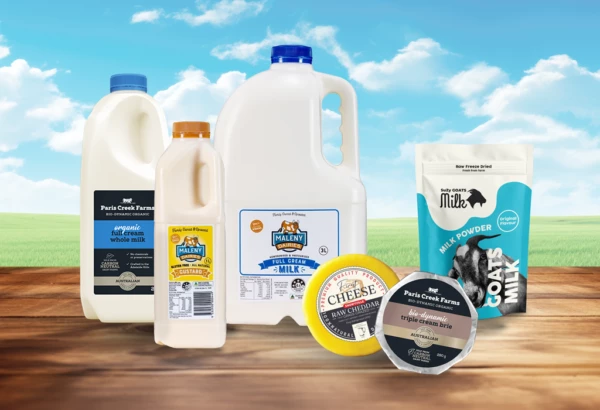I. What Packaging Is Suitable For Dry Goods?
| Packaging Type | Best Dried Goods |
| Glass
| Preserves like jams, honey, and pickles Specialty spices or herbs |
Folded Carton | Cereals & grains Baked goods Coffee & Tea Electronics Chocolate |
Stand-up Pouches | Snacks like granola Pet food Coffee High-moisture items like beef jerky |
| Gusseted Bags
| Gourmet baking mixes & specialty flours Premium pet treats Artisanal spices |
| Box-bottom Bags
| Premium snacks Coffee & Tea Pet food Luxury dry goods like artisan pasta |
| Centre-seal Bags
| Single-serving snacks Dried fruits Powders Grains |
II. What Packaging Material Is Commonly Used In Packaging Dried Food?
There are various food packaging materials used today. Let’s take a look at a few.
| Laminates | Used for snacks, chips, coffee, and ready-to-eat meals. |
| Mylar (Metallized Polyester) | Used for snacks, dried fruits, dried vegetables, chocolate, and candy. |
| Polypropylene (PP) | Used for yoghurt, frozen meals, pasta, and rice packaging. |
| Glass jars | Used for pickles, preserves, jams, jellies, honey, sauces. Even dry goods, cereals, and spices! |
III. What Packaging Trends Should I Consider For Dried Food?
According to Smithers’ research on The Future of Flexible Packaging, Edible Food Packaging, there’s been a trend in recent years focusing on the switch from rigid food packaging to more flexible options. This has come as a result of the need to reduce the environmental ramifications of food packaging and meet consumer demand for more sustainable, high-quality packaging options. Here are awesome packaging trends worth considering.
Including 2 types: active and intelligent packaging. The former can improve qualities like a food’s freshness, while the latter can include technologies such as QR codes or NFC tags.
Sustainable packaging is all about taking a holistic approach to product packaging and ensuring they make as little impact on the environment as possible.
Finally, a sachet is all about packaging that contains just the right amount of what you need, nothing more or less. Already common with salt, pepper, and other spices and sauces, they are becoming increasingly popular in different industries.
IV. What Labelling Requirements Are Important For Dried Food Packaging?
1. Understanding Product Characteristics
It’s crucial that manufacturers understand their product’s characteristics.
- For moisture-rich items (e.g: dried fruits): Use packaging that prevent air and moisture from entering to avoid microbial growth
- For fine powered products that can easily spill (e.g: flour): tightly sealing and durable packaging is essential to prevent leakage.
2. Understanding Product Size & Shape
In regards to product size and shape, you should consider cans and tins for larger, more irregular products. For smaller, granular products, pouches are your best bet.
3. Understanding Shelf-Life & Preservation
Different products have differing reactions to external elements like air, moisture, and temperature. Knowing how your product reacts is key to ensuring proper preservation and a prolonged shelf-life.
4. Understanding Consumer Usability
How a consumer interacts with a product is also necessary to know. For example, for products used over extended periods of time, such as coffee and spices, resealability is paramount.
5. Understanding Regulatory Standards
Understanding food labels & packaging means you, as the manufacturer, must abide by a variety of regulatory standards to ensure consumer safety. These include accurate nutritional information, proper labelling of ingredients, expiration date, etc.
V. How Can I Make My Dried Food Packaging Visually Appealing?
Some ways to make your dried food packaging visually appealing are:
- Choose the right colour palette
- Use clear, easy to read fonts
- Incorporate unique shapes and sizes
- Highlight key information to quick readability
- Keep the design clean
- Stand out from competitors with creativity
VI. How Does Size & Shape Affect Dried Food Packaging Design?
1. What’s The Impact Of Size?
Size affects dried food packaging design when it comes to storage, handling, shelf appeal.
- For larger packages: They require sturdier designs in order to maintain the product kept inside.
- For smaller packages: they should be more portable and lightweight. On top of this, when smaller packages are placed in a store, it’s easier to encourage impulse buys.
2. What’s The Impact Of Shape?
Shape is also key, in the sense that it needs to fit a product and facilitate ease of use. Unique shapes can enhance visual appeal and branding but sometimes it’s best to go for simpler shapes for cleaner looks.
VII. How Can I Incorporate Technology Into My Dried Food Packaging?
Consider QR codes and smart labels as one of the best technologies to incorporate into your dried food packaging. Here’s how:
- QR codes: Customers can scan the code with their smartphones to access additional product information, such as nutritional facts, ingredient origins, or even preparation tips.
- Smart labels: These can give consumers insights into supply chain data, where the ingredients are sourced from, expiration updates or sustainability efforts.

VIII. Discover The Right Packaging For Your Food With QLM Group
If you’re in need of a company to take your dry food packaging to the next level, look no further than QLM Group. With a variety of benefits including:
- Labels that are resistant to water, moisture, and oils
- Colour coding for flavours or styles
- Promotional labels and tags that help a product stand out
- Nutritional panels and barcoding systems
- Easy pairing with coloured cartons and dispatch labels!
Whatever dry food packaging you’re interested in having made, all you have to do is contact us now for more information.



















